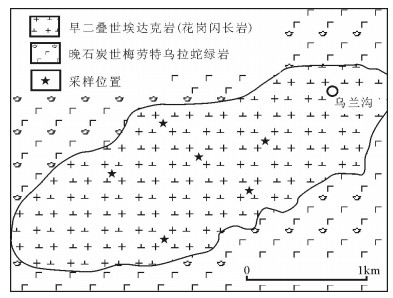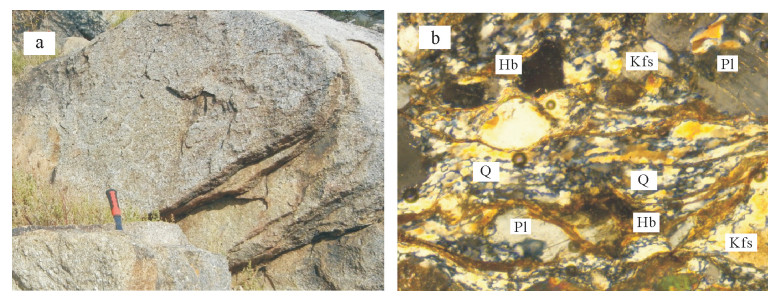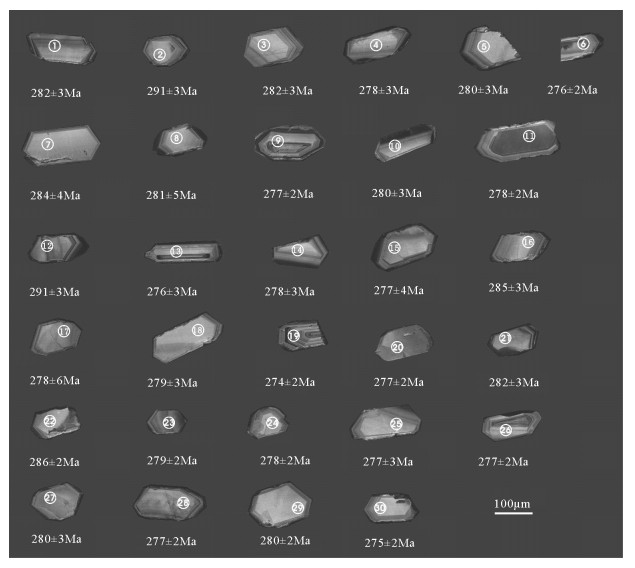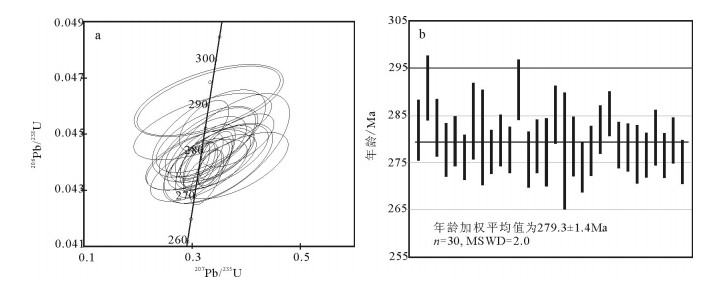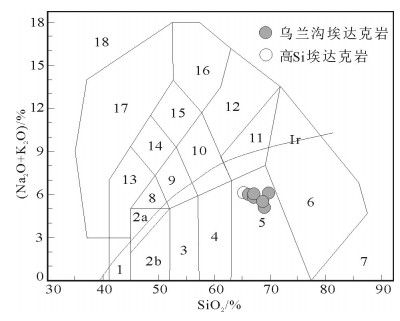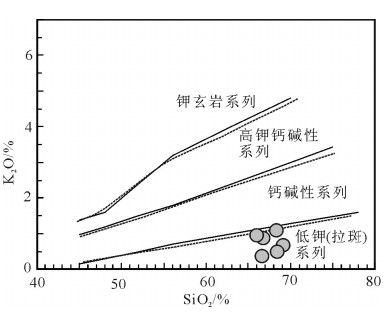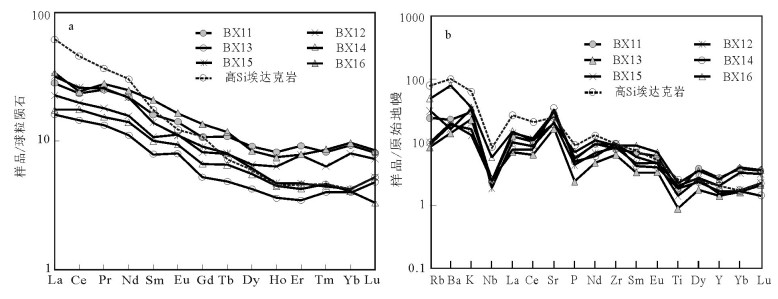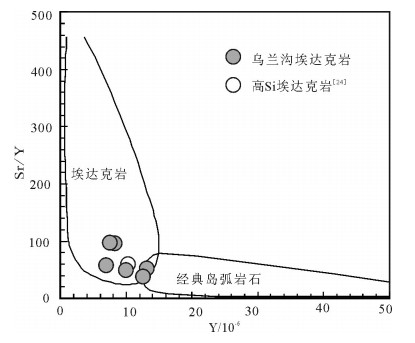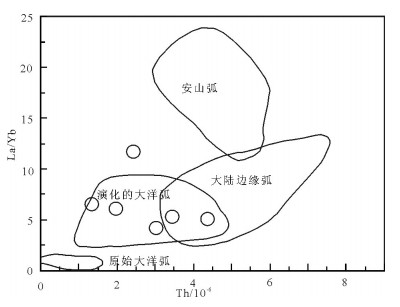Zircon U-Pb dating and tectonic setting of the Wulan'gou adakite in Inner Mongolia
-
摘要:
内蒙古中部贺根山缝合带的梅劳特乌拉蛇绿岩中,新发现乌兰沟埃达克岩,岩性为花岗闪长岩。LA-ICP-MS锆石UPb测年结果表明,乌兰沟埃达克岩的侵位年龄为279.3±1.4Ma,其形成时代为早二叠世。乌兰沟埃达克岩SiO2含量为65.92%~69.65%,MgO为1.34%~2.16%,Al2O3为15.30%~17.33%,Na2O/K2O值为3.95~14.09,Sr=359.60×10-6~734.00×10-6,Yb=0.83×10-6~2.02×10-6,Y=6.65×10-6~12.84×10-6;富集K、Rb、Sr等大离子亲石元素,亏损Nb、Ta、Ti、P等高场强元素;稀土元素总量为32.18×10-6~65.41×10-6,明显较低,轻、重稀土元素分馏明显,(La/Yb)N值为2.84~7.56,无明显Eu异常,显示出高硅埃达克岩(HSA)的地球化学特征。该埃达克岩具有岛弧型岩浆岩特征,形成于俯冲带岛弧环境,可能为洋内俯冲洋壳+俯冲深积物部分熔融并与上覆地幔楔橄榄岩反应成因。根据乌兰沟埃达克岩与梅劳特乌拉蛇绿岩的时空分布与演化特征,贺根山缝合带在早二叠世可能存在洋内俯冲作用。
Abstract:The newly recognized Wulan'gou adakite in the Meilaotewula ophiolite along the Hegenshan suture zone in Inner Mongolia consists mainly of granodiorites. The LA-ICP-MS zircon U-Pb dating shows that the age of the adakite is 279.3±1.4Ma, suggesting a product of Early Permian. The rock has high SiO2 (65.92%~69.65%), Al2O3 (15.30%~17.33%), Sr(359.60×10-6~734.00×10-6), and low MgO(1.34%~2.16%), Yb(0.83×10-6~2.02×10-6), Y(6.65×10-6~12.84×10-6) content, with Na2O/K2O ratio varying from 3.95 to 14.09. The adakiteis enriched in large ion lithophile elements K, Rb and Sr, and depleted in high field strength elements Nb, Ta, Ti and P. The total REE is low(32.18×10-6~65.41×10-6), whereas REE fractionation is clear((La/Yb)N=2.84~7.56), without obvious Eu anomaly. All of the geochemical characteristics indicate that the Wulan'gou pluton belongs to high-SiO2 adakites (HSA). The adakiteis characterized by the island-arc magmatite generated in subduction zone, which suggests that it might have been formed in an island arc setting in petrology and geochemistry. It might have been derived from the intra-oceanic subducted oceanic crust plus sediment partial melting and subsequently melts reaction with overlying mantle wedge peridotite. According to the temporal and spatial distribution and evolution characteristics of the rock assemblage series of pillow tholeiite, boninite, Nb-enriched basalt, High-Mg diorite and adakite in the Meilaotewula ophiolite, the authors suggest that there might have been an intra-oceanic subduction in the Hegenshan suture zone during the Early Permian period.
-
致谢: 审稿专家对稿件提出了建设性的修改意见,在此表示衷心的谢意。
-
图 6 乌兰沟埃达克岩TAS分类图解[24]
Figure 6. Total alkali versus silica(TAS) diagram of the Wulan'gou adakite
图 7 乌兰沟埃达克岩SiO2-K2O分类图解[25]
Figure 7. SiO2-K2O classification diagram of the Wulan'gou adakite
图 10 乌兰沟埃达克岩SiO2-MgO(a)、(CaO+NaO2)-Sr(b)、Y-Sr/Y(c)和SiO2-Nb(d)图解[24]
Figure 10. SiO2-MgO(a), (CaO+NaO2)-Sr (b), Y-Sr/Y(c)and SiO2-Nb(d)diagrams of the Wulan'gou adakite
图 11 乌兰沟埃达克岩(Y+Nb)-Rb构造判别图解[52]
syn-COLG —同碰撞花岗岩;VAG—火山弧花岗岩;WPG—板内花岗岩;ORG—洋脊花岗岩
Figure 11. (Y+Nb)-Rb tectonic discriminant diagram of the Wulan'gou adakite
图 12 乌兰沟埃达克岩Th-La/Yb构造判别图解[53]
Figure 12. Th-La/Ybtectonic discriminant diagram of the Wulan'gou adakite
表 1 乌兰沟埃达克岩(BX14)LA-ICP-MS锆石U-Th-Pb测试结果
Table 1 LA-ICP-MS U-Th-Pb dating results of zircons from the Wulan'gou adakite(BX14)
点号 Pb/10-6 U/10-6 Th/U 同位素原子比率 表面年龄/Ma 207Pb*/206Pb* ±% 207Pb*/235U ±% 206Pb*/238u ±% 206Pb/238U 1 6 137 0.22 0.0545 11 0.3362 10 0.04471 1.2 282 ±3 2 8 164 0.21 0.0523 16 0.3328 16 0.04623 1.2 291 ±3 3 5 124 0.19 0.0528 12 0.3258 12 0.04482 1.1 282 ±3 4 8 183 0.22 0.0545 10 0.3310 9.4 0.04404 1.0 278 ±3 5 8 190 0.20 0.0532 6.9 0.3250 6.9 0.04429 0.92 280 ±3 6 16 369 0.26 0.0522 4.3 0.3153 4.3 0.04376 0.82 276 ±2 7 5 110 0.20 0.0534 14 0.3315 13 0.04501 1.4 284 ±4 8 5 115 0.22 0.0594 13 0.3644 13 0.04448 1.8 281 ±5 9 15 354 0.24 0.0566 3.6 0.3430 3.6 0.04397 0.83 277 ±2 10 7 155 0.23 0.0562 8.7 0.3440 8.5 0.04435 0.98 280 ±3 11 10 230 0.25 0.0579 7.7 0.3518 7.8 0.04401 0.87 278 ±2 12 6 140 0.27 0.0519 18 0.3303 17 0.04623 1.1 291 ±3 13 5 114 0.27 0.0517 12 0.3118 12 0.04372 1.1 276 ±3 14 5 127 0.23 0.0519 13 0.3158 13 0.04413 1.0 278 ±3 15 4 90 0.26 0.0574 13 0.3479 12 0.04402 1.3 277 ±4 16 5 100 0.30 0.0514 17 0.3209 16 0.04518 1.1 285 ±3 17 2 55 0.22 0.0838 21 0.5081 20 0.04404 2.2 278 ±6 18 5 109 0.28 0.0540 15 0.3289 14 0.04436 1.1 279 ±3 19 14 354 0.063 0.0547 3.8 0.3275 3.9 0.04354 0.91 274 ±2 20 18 422 0.21 0.0499 4.0 0.3022 4.1 0.04392 0.83 277 ±2 21 13 301 0.16 0.0624 7.0 0.3846 7.1 0.04471 0.89 282 ±3 22 12 270 0.23 0.0515 5.8 0.3214 5.8 0.04529 0.83 286 ±2 23 11 252 0.25 0.0522 7.4 0.3181 7.5 0.04416 0.88 279 ±2 24 11 249 0.27 0.0505 6.7 0.3071 6.6 0.04411 0.90 278 ±2 25 5 122 0.20 0.0631 10.6 0.3816 10 0.04393 1.1 277 ±3 26 13 306 0.30 0.0541 5.3 0.3269 5.3 0.04392 0.86 277 ±2 27 6 133 0.20 0.0521 10 0.3195 10 0.04465 1.0 280 ±3 28 13 312 0.19 0.0511 4.5 0.3092 4.6 0.04381 0.83 277 ±2 29 12 270 0.18 0.0589 5.9 0.3601 6.2 0.04438 0.86 280 ±2 30 11 258 0.20 0.0520 5.8 0.3128 5.7 0.04356 0.85 275 ±2 注:误差为1σ;Pb*指示放射成因铅。实验测试在天津地质矿产研究所完成 表 2 乌兰沟埃达克岩主量、微量和稀土元素分析结果
Table 2 Major elements, trace elements and REE analyses of the Wulan'gou adakite in the Meilaote ophiolite
样号 BX11(xγδP1) BX12(xγδP1) BX13(xγδP1) BX14((zγδP1) BX15(xγδP1) BX16(xγδP1) 高Si埃达克岩 SiO2 66.80 65.92 69.65 68.82 66.68 68.35 64.80 TiO2 0.40 0.45 0.20 0.42 0.32 0.51 0.56 Al2O3 16.59 17.25 17.08 15.79 17.33 15.30 16.64 Fe2O3 1.47 0.83 1.72 1.60 1.16 2.12 4.75 FeO 1.53 2.13 0.65 1.14 1.03 1.32 MnO 0.061 0.052 0.034 0.068 0.029 0.054 0.081 MgO 1.73 2.16 1.59 1.44 1.60 1.34 2.18 CaO 3.56 2.79 1.83 3.67 4.65 2.70 4.63 Na2O 4.88 5.03 5.44 4.70 5.71 4.41 4.19 K2O 0.96 1.04 0.72 0.51 0.41 1.12 1.97 P2O5 0.1:0 0.102 0.052 0.110 0.131 0.161 0.200 烧失量 1.78 2.16 1.00 1.65 0.86 2.47 总计 99.88 99.90 99.96 99.91 99.90 99.86 Mg# 52 57 56 50 58 43 48 La 8.79 7.05 4.97 5.43 9.91 10.57 19.20 Ce 18.99 16.11 11.75 14.30 21.18 19.64 37.30 Pr 3.06 2.21 1.63 1.88 3.14 3.42 Nd 13.26 9.46 6.65 8.41 13.08 14.93 18.20 Sm 3.14 2.11 1.53 1.95 2.72 4.09 3.40 Eu 1.04 0.82 0.59 0.69 0.81 1.22 0.90 Gd 2.77 2.12 1.36 1.72 2.35 3.51 2.80 Tb 0.52 0.38 0.23 0.31 0.38 0.56 Dy 2.92 2.10 1.36 1.78 1.97 2.71 1.90 Ho 0.59 0.46 0.26 0.32 0.34 0.54 Er 1.94 1.64 0.73 0.89 0.98 1.65 0.96 Tm 0.27 0.21 0.13 0.15 0.14 0.28 Yb 1.75 1.68 0.83 0.85 0.88 2.02 0.88 Lu 0.27 0.24 0.16 0.11 0.17 0.28 0.17 ∑REE 59.30 46.58 32.18 38.79 58.06 65.41 Y 12.84 9.69 6.65 7.99 7.27 12.31 10.00 Ba 166.30 118.40 100.50 135.20 146.50 580.80 721.00 Rb 15.98 20.72 5.50 6.10 6.58 32.62 52.00 Sr 622.52 447.88 359.60 734.00 669.32 437.11 565.00 Zr 90.90 94.70 73.90 110.00 110.70 102.00 108.00 Nb 1.77 1.39 1.94 1.78 1.83 4.26 6.00 Th 4.37 3.02 1.97 1.34 2.43 3.45 Ni 19.52 23.30 3.60 11.20 17.24 10.32 20.00 V 61.81 53.32 18.90 49.00 56.35 74.87 95.00 Cr 37.24 30.98 4.30 16.50 44.67 26.09 41.00 Hf 5.83 5.25 3.59 4.97 3.38 8.76 Sc 9.25 8.48 3.74 6.91 7.52 6.04 Ta 0.22 0.19 0.21 0.18 0.24 0.39 Co 9.20 9.41 2.40 8.50 9.80 7.56 Li 7.10 10.03 7.44 15.74 3.33 13.35 U 0.60 0.49 0.51 0.24 0.50 0.89 注:主量元素含量单位为%,稀土、微量元素为10-6;xγδP1—细粒花岗闪长岩,zγδP1—中粒花岗闪长岩,高Si埃达克岩为267个样品的平均值[24] -
Defant M J, Drummond M S. Derivation of some modern arc magmas by melting of young subducted lithosphere[J]. Nuture, 1990, 347(18):662-665. http://www.nature.com/articles/doi:10.1038%2F347662a0
Defant J D. Mount S T. Helens:potential exemple of the partial melting of the subducted lithosphere in a volcanic arc[J]. Geology, 1993, 21(6):547-550. doi: 10.1130/0091-7613(1993)021<0547:MSHPEO>2.3.CO;2
Sajona F G, Maury R C, Bellon H, et al. Initiation of subduction and the generation of slab melts in western and eastern Mindanao.Philippines[J]. Geology, 1993, 21:1007-1010. doi: 10.1130/0091-7613(1993)021<1007:IOSATG>2.3.CO;2
Stern C R, Killian R. Role of the subducted slab, mantle wedge and continental crnst in the generation of adakites from the Andean Austral Volcanic Zone[J]. Contrib. Mineral. Petrol., 1996, 123:263-281. doi: 10.1007/s004100050155
Samaniego P, Martin H, Robin C, et al. Transition from talc-alkalic to adakitic magmatism at Cayambe volcano, Ecuador; insights into slab melts and mantle wedge interactions[J]. Geological Society of America, 2002, 30(11):967-970. http://adsabs.harvard.edu/abs/2002Geo....30..967S
Bourdon E, Eissen J P, Gutscher M A, et al. Magmatic response to early aseismic ridge subduction:the Ecuadorian margin case(South America)[J]. EPSL, 2003, 205:123-138. doi: 10.1016/S0012-821X(02)01024-5
刘敦一, 简平, 张旗, 等.内蒙古图林凯蛇绿岩中埃达克岩SHRIMP测年:早古生代洋壳消减的证据[J].地质学报, 2003, 77(3):317-330. doi: 10.3321/j.issn:0001-5717.2003.03.004 梁日暄.内蒙古中段蛇绿岩特征及地质意义[J].中国区域地质, 1994, (1):37-45. http://www.wanfangdata.com.cn/details/detail.do?_type=perio&id=QK199400629562 陈斌, 赵国春, Wilde S.内蒙古苏尼特左旗南两类花岗岩同位素年代学及其构造意义[J].地质论评, 2001, 47(4):361-367. doi: 10.3321/j.issn:0371-5736.2001.04.005 Miao L, Shi Y, Guo F. Geochronology and geochemistry of the Hegenshan ophiolitic complex:Implications for late-stage tectonic evolution of the Inner Mongolia-Daxinganling Orogenic Belt, China[J]. Journal of Asian Earth Sciences, 2008, 32(4):404-415. http://www.sciencedirect.com/science/article/pii/S1367912007002222
刘建峰, 迟效国, 张兴洲, 等.内蒙古西乌旗南部石炭纪石英闪长岩地球化学特征及其构造意义[J].地质学报, 2009, 83(3):365-376. http://d.old.wanfangdata.com.cn/Periodical/dizhixb200903006 Jian P, Kröner A, Windley B F, et al. Carboniferous and Cretaceous mafic-ultramafic massifs in Inner Mongolia (China):A SHRIMP zircon and geochemical study of the previously presumed integral 'Hegenshan ophiolite'[J]. Lithos, 2012, 142/143:48-66. doi: 10.1016/j.lithos.2012.03.007
石玉若, 刘翠, 邓晋福, 等.内蒙古中部花岗质岩类年代学格架及该区构造岩浆演化探讨[J].岩石学报, 2014, 30(11):3155-3171. http://d.old.wanfangdata.com.cn/Periodical/ysxb98201411005 李英杰, 王金芳, 王根厚, 等.内蒙古迪彦庙蛇绿岩带达哈特前弧玄武岩的发现及其地质意义[J].岩石学报, 2018, 34(2):469-482. http://d.old.wanfangdata.com.cn/Periodical/ysxb98201802019 李英杰, 王金芳, 李红阳, 等.内蒙古西乌旗梅劳特乌拉蛇绿岩的识别[J].岩石学报, 2015, 31(5):1461-1470. http://d.old.wanfangdata.com.cn/Periodical/ysxb98201505020 王金芳, 李英杰, 李红阳, 等.内蒙古梅劳特乌拉蛇绿岩中早二叠世高镁闪长岩的发现及洋内俯冲作用[J].中国地质, 2018, 45(4):706-719. http://d.old.wanfangdata.com.cn/Periodical/zgdizhi201804006 王金芳, 李英杰, 李红阳, 等.内蒙古西乌旗石匠山晚侏罗世-早白垩世A型花岗岩锆石U-Pb年龄及构造环境[J].地质通报, 2018, 37(2/3):382-396. http://dzhtb.cgs.cn/ch/reader/view_abstract.aspx?file_no=2018020317&flag=1 王金芳, 李英杰, 李红阳, 等.内蒙古梅劳特乌拉蛇绿岩中埃达克岩的发现及其演化模式[J].地质学报, 2017, 91(8):1776-1795. doi: 10.3969/j.issn.0001-5717.2017.08.009 王金芳, 李英杰, 李红阳, 等.内蒙古西乌旗努和特早白垩世A型花岗岩LA-ICPMS锆石U-Pb年龄及其地质意义[J].地质通报, 2017, 36(8):1343-1358. doi: 10.3969/j.issn.1671-2552.2017.08.005 张玉清.内蒙古苏尼特左旗巴音乌拉二叠纪埃达克质花岗闪长岩类地球化学特征及其地质意义[J].岩石矿物学杂志, 2009, 28(4):329-338. doi: 10.3969/j.issn.1000-6524.2009.04.003 Anderson T. Correction of commen lead U-Pb analyses that do not report 204Pb[J]. Chemical Geology, 2002, 192:59-79. doi: 10.1016/S0009-2541(02)00195-X
Ludwig K R. Users Manual for Isoplot/Ex(rev. 2. 4):A Geochronologica toolkit for microsoft excle[J]. Berkeley Geochronology Center Special Publication, 2001, l:1-55.
Corfu F, Hanchar J M, Hoskin P W O. Atlas of Zircon Textures[J]. Reviews in Mineralogy & Geochemistry, 2003, 53(1):469-500. doi: 10.2113-0530469/
Martin H, Smithies R H, Rapp R, et al. An overview of adakite, tonalite-trondhjemite-granodiorite (TTG), and sanukitoid:Relationships and some implications for crustal evolution[J]. Lithos, 2005, 79(1/2):1-24. http://www.sciencedirect.com/science/article/pii/S002449370400266X
Peccerillo A, Taylor S R. Geochemistry of eocene calc-alkaline volcanic rocks from the Kastamonu Area, NorthernTurkey[J]. Contributions to Mineralogy and Petrology, 1976, 58:63-81. doi: 10.1007/BF00384745
Kelemen P B, Hangh K, Greenem A R. One view of the geochemistry of subduction-related magmatic arcs, with an emphasis on primitive andesite and lower crust[C]//Rudnick R L. Treatise On Geochemistry, 2003, 3: 593-659.
Boynton W V. Geochemistry of the rare earth elements: meteorite studies[C]//Henderson P. Rare Earth Element Geochemistry.Elsevier, 1984: 63-114.
Sun S S, McDonough W F. Chemical and isotope systematics of oceanic basalts:implications for mantle composition and processes[J]. Geological Society of London, Special Publication, 1989, 42:313-345. doi: 10.1144/GSL.SP.1989.042.01.19
王焰, 张旗, 钱青.埃达克(adakite)的地球化学特征及其构造意义[J].地质科学, 2000, 35(2):251-256. doi: 10.3321/j.issn:0563-5020.2000.02.016 许立权, 邓晋福, 陈志勇.内蒙古达茂旗北部奥陶纪埃达克岩类的识别及其意义[J].现代地质, 2003, 17(4):428-434. doi: 10.3969/j.issn.1000-8527.2003.04.011 石玉若, 刘敦一, 张旗, 等.内蒙古苏左旗白音宝力道Adakite质岩类成因探讨及其SHRIMP年代学研究[J].岩石学报, 2005, 21(1):143-150. http://d.old.wanfangdata.com.cn/Periodical/ysxb98200501014 郝百武.内蒙古那仁乌拉埃达克质花岗岩的发现、成因、锆石UPb年龄及其构造意义[J].矿物岩石, 2012, 32(1):28-39. doi: 10.3969/j.issn.1001-6872.2012.01.005 Martin H. Adakitic magmas:modern analogues of Archaean granitoids[J]. Lithos, 1999, 46:411-429. doi: 10.1016/S0024-4937(98)00076-0
王强, 赵振华, 许继峰.天山北部石炭纪埃达克岩-高镁安山岩-富Nb岛弧玄武质岩:对中亚造山带显生宙地壳增生与铜金成矿的意义[J].岩石学报, 2006, 22(1):11-30. http://d.old.wanfangdata.com.cn/Periodical/ysxb98200601002 张乐, 董永胜, 张修政, 等.藏北羌塘中西部红脊山地区早二叠世埃达克质岩石的发现及其地质意义[J].地质通报, 2014, 33(11):1728-1739. doi: 10.3969/j.issn.1671-2552.2014.11.009 王冬兵, 罗亮, 唐渊, 等.昌宁-孟连结合带牛井山早古生代埃达克岩锆石U-Pb年龄、岩石成因及其地质意义[J].岩石学报, 2016, 32(8):2317-2329. http://d.old.wanfangdata.com.cn/Periodical/ysxb98201608006 Kelemen P B. Genesis of high Mg# andesites and the continental crust[J]. Contributions to Mineralogy and Petrology, 1995, 120(1):1-19. doi: 10.1007/BF00311004
Kepezhinskas P K, Defant M J, Drummond M S. Na metasomatism in the island-arc mantle by slab melt-peridotite interaction:Evidence from mantle xenoliths in the north Kamchatka arc[J]. Journal of Petrology, 1995, 36(6):1505-1527. http://petrology.oxfordjournals.org/content/36/6/1505.short
Yogodzinski G M, Lees J M, Churikova T G, et al. Geochemical evidence for the melting of subducting oceanic lithosphere at plate edges[J]. Nature, 2001, 409(6819):500-504. doi: 10.1038/35054039
Hou Z Q, Gao Y F, Qu X M. Origin of adakitic intrusives generated during mid-Miocene eastwest extension in southern Tibet[J]. Earth Planet. Sci. Lett., 2004, 220:139-155. doi: 10.1016/S0012-821X(04)00007-X
Wang Q, McDermott F, Xu J F, et al. Cenozoic K-rich adakitic volcanic rocks in the Hohxil area, northern Tibet:Lower-crustal melting in an intracontinental setting[J]. Geology, 2005, 33:465-468. doi: 10.1130/G21522.1
Xu W L, Hergt J M, Gao S, et al. Interaction of adakitic melt-peridotite:Implications for the high-Mg# signature of Mesozoic adakitic rocks in the eastern North China Craton[J]. Earth and Planetary Science Letters, 2008, 265(1/2):123-137. doi: 10.1007%2Fs11434-009-0307-z
Atherton M P, Petford N. Generation of sodium-rich magmas from newly underplated basaltic crust[J]. Nature, 1993, 362(6416):144-146. doi: 10.1038/362144a0
Rapp R P, Watson E B. Dehydration melting of metabasalt at 8~32kbar:Implications for continental growth and crust-mantle recycling[J]. Journal of Petrology, 1995, 36(4):891-931. doi: 10.1093/petrology/36.4.891
Rapp R P, Shimizu N, Norman M D. Reaction between slab-derived melts and peridotite in the mantle wedge:Experimental constraints at 3.8GPa[J]. Chemical Geology, 1999, 160(4):335-356. doi: 10.1016/S0009-2541(99)00106-0
Thorkelson D J, Breitsprecher K. Partial melting of slab window margins:genesis of adakitic and non-adakitic magmas[J]. Lithos, 2005, 79:24-41. http://www.sciencedirect.com/science/article/pii/S0024493704002671
Viruete J E, Contreras F, Stein C.Magmatic relationships and ages between adakites, magnesian andesites and Nb-enriched basalt-andesites from Hipaniola:record of a major change in the Caribbean island arc magma sources[J]. Lithos, 2007, 99(3/4):151-177. http://www.sciencedirect.com/science/article/pii/S0024493707000187
Reagan M K. The geology of the Southern Mariana fore-arc crust:Implications for the scale of Eocene Volcanism in the western pacific[J]. Earth and Planetary Science Letters, 2013, 380:41-51. doi: 10.1016/j.epsl.2013.08.013
Ishizuka O, Tani K, Reagan M. Kizu-Bonin-Mariana forearc Crust as a modern ophiolite Analogue[J]. Elements, 2014, 10:115-120. doi: 10.2113/gselements.10.2.115
肖庆辉, 李廷栋, 潘桂棠.识别洋陆转换的岩石学思路-洋内弧与初始俯冲的识别[J].中国地质, 2016, 43(3):721-737. http://www.wanfangdata.com.cn/details/detail.do?_type=perio&id=QKC20162016072100012266 Peacock S M, Rushmer T, Thompson A B. Partial melting of subducting oceanic crust[J]. Earth Planet. Sci. Lett., 1994, 121:227-244. doi: 10.1016/0012-821X(94)90042-6
Pearce J A, Lippard S J, Roberts S. Characteristics and tectonic significance of supra-subduction zone ophiolites[C]//Kokelaar B P. Howells M F. Marginal Basin Geology. Geological Society of London Special Publication, 1984, 16: 77-94.
Condie K C. Geochemistry and tectonic setting of early proterozoic supracrustal rocks in the southwest united states[J]. J. Geology., 1986, 94:845-861. doi: 10.1086/629091



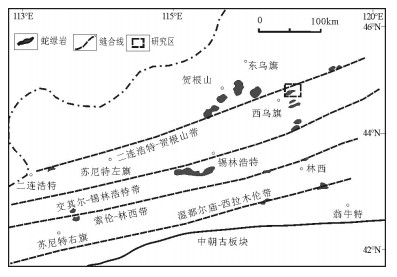
 下载:
下载:
